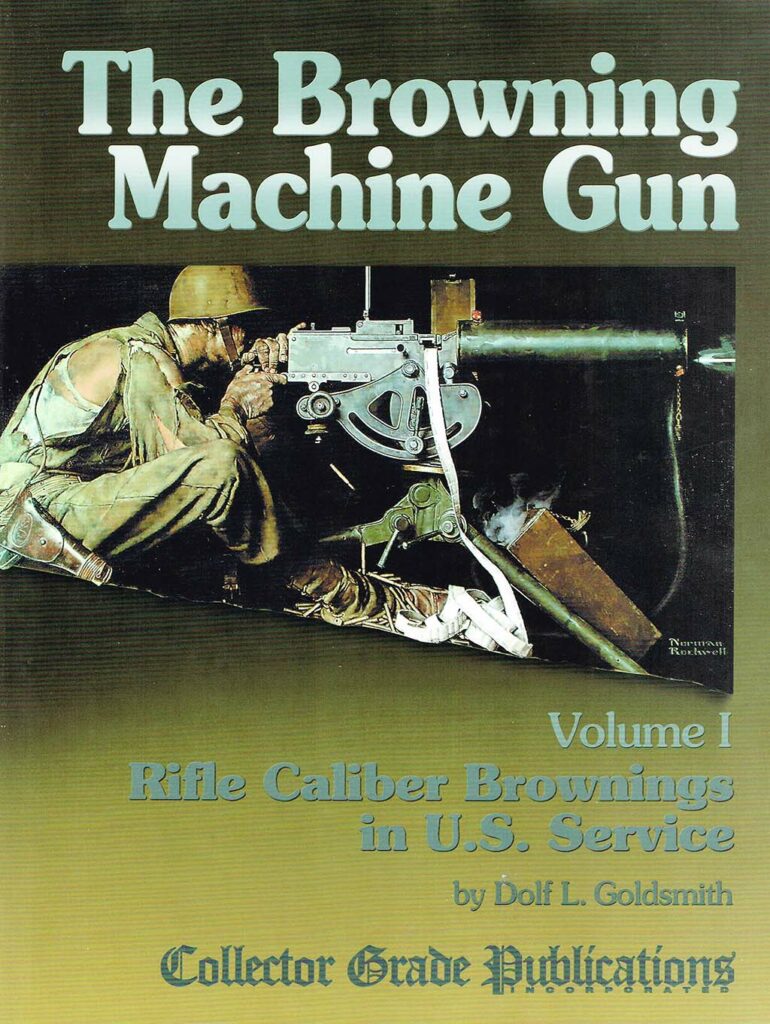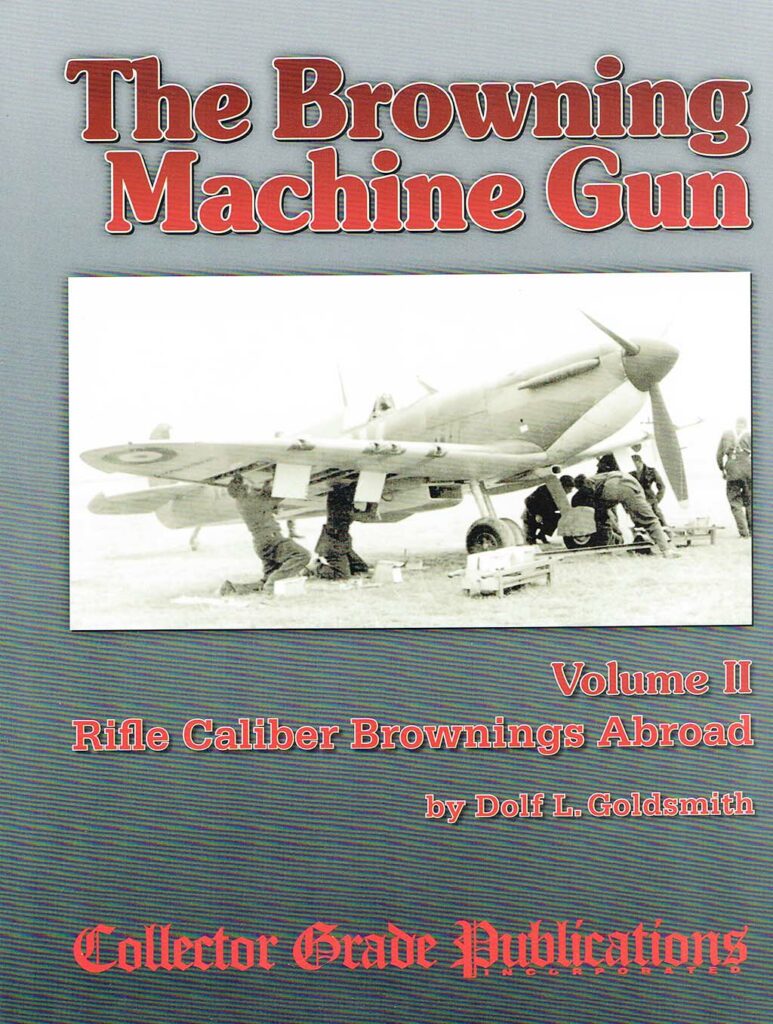By Dean Roxby


As we patiently wait for the newest book by highly respected author Dolf Goldsmith to be released, I feel a look back at his previous series of books on the Browning family of belt-fed machine guns is in order. (The Vickers Machine Gun: Pride of the Emma Gees is an update of his classic title, The Grand Old Lady of No Man’s Land. Released in 1994, Grand Old Lady is long sold out and is very expensive on the used market. As I write this, I see asking prices of $690 to $920 on Amazon.)
The Browning Machine Gun series of books was originally planned to be a set of three books covering the .30-caliber guns. Volume I explores the early development phase of John M. Browning’s machine guns, their use in the latter days of WWI, further refinement between the Wars and their huge influence in WWII in U.S. service. Volume II covers the use of rifle-caliber Brownings in foreign use prior to and during WWII. Volume III covers mounts and all the various accessories and tools, etc. Later, a fourth volume covering the mighty .50-caliber M2 family joined the set. In 2016 this was followed by Volume V: Dolf’s Notebook, containing hints and tips for working on Browning machine guns. The first four volumes are published by Collector Grade Publications, while the fifth is published by Chipotle Publishing, LLC.
The first two volumes will be reviewed this issue. I hope to review the others in due time.
Collector Grade Publications has earned a well-deserved reputation for producing quality, in-depth reference books about military firearms, and these two books certainly meet the standard. These two books follow the established Collector Grade format of dividing the subject into parts, then into chapters, with each chapter further divided into many short segments. Often these segments are only a paragraph long.
Volume I
Volume I, “Part I: Gas Operation,” looks back at John Browning’s first experiments with full-auto guns. He first converted a Winchester Model 1873 lever action to fire full-auto by harnessing the muzzle blast to cycle the lever back and forth via a linkage rod and cup arrangement. He referred to this device as an “Automatic Magazine Gun.” He then designed a belt-fed gun he called the “Apparatus.” Although extremely crude looking, this worked well enough to prove the concept. In 1892, he (along with his brother Matt) obtained patents for both devices.
Soon, Browning was able to interest Colt’s Patent Fire Arms Manufacturing Company in his design. It matured into the gas-operated Model 1895 “Potato Digger” gun and became the first true automatic gun in U.S. service, used first by the Navy. Volume I also covers foreign sales of the M1895 and the improved Model 1914 in the period leading up to and including WWI. The book features numerous, fascinating, old photos from the mid-1890s to the WWI era.
Part I, Chapter Two deals with the M1914 guns built under license by the Marlin Firearms Company. Several variants such as the Tank Gun, the Model 1917 and Model 1918 Aeroplane Gun are profiled.
“Part II: The Switch to Recoil Operation” details John Browning’s move to design a recoil-operated machine gun. In fact, Browning had already designed and patented a recoil-powered shotgun for the civilian market. This was the FN-produced Browning A-5. Having acquainted himself with the recoil principle, he then applied this to a machine gun, the Model 1901. This led to the Model 1917, as covered in “Part III: The Browning in World War I.”
“Part IV: The Interwar Brownings, Chapter Seven, The M1917 Becomes the M1917A1” is a long, detailed look at the water-cooled gun. “Chapter Eight, Early Aircraft Machine Guns” follows the Model 1918 air-cooled gun. There are many intriguing variants and mounts featured here. Part V studies the M2 Aircraft gun (not to be confused with the .50-caliber M2HB).
“Part VI: Manufacturing Brownings for WWII” is where we are introduced to the iconic M1919A4 and M1919A6 of WWII fame. The massive War effort is dealt with here, including sections on production by Rock Island Arsenal and Saginaw Steering Gear (SSG, once a division of General Motors Corp.). I found the SSG segment very interesting. At first, there was some concern that as SSG had never built any type of firearms before, they would not be able to build a complex machine gun. SSG eventually built nearly 368,000 M1919A4 guns by June 1945. More amazing, the cost per gun dropped from $657.75 per gun for the first small batch, to an astonishing $54.72 per gun! Also, the total man-hours per gun dropped from 76 to 12 man-hours per gun.
“Part VII: Brownings in WWII” uses many personal recollections of the M1919A4 and A6 in combat. Likewise, “Part VIII: The Latter Days” looks at post-WWII use, including personal recollections from Korea. The book closes with a rather uncomplimentary look at the gun that replaced the Browning series of guns, the M60.
Volume II
While Volume I covers the development of the early prototypes in great detail and the adoption by U.S. services, Volume II deals with Browning machine guns in foreign service. As the guns were highly refined at this point (Pre-WWII era), Volume II does not cover the earliest days all over again. Rather, it briefly touches on guns from the interwar years (1920s and 1930s), then goes right into WWII service. Initially, this meant aircraft guns mostly, but later included ground guns as well.
Again, as is the Collector Grade way, Volume II is divided into parts and chapters. Part I is “The Browning in Britain.” This deals with the air-cooled, aircraft guns primarily. Interestingly, these aircraft guns were chambered for the .303 British cartridge. The Hawker Hurricane and the Supermarine Spitfire each were armed with eight Brownings, four in each wing. Many historians believe this decision, made several years before the start of the War, helped to win the Battle of Britain.
“Part II: British Commonwealth Brownings” looks at the gun’s use in Australia, Canada, New Zealand and South Africa. The chapter covering Canada is the longest and deals with WWII production by two Canadian firms, later Browning use in Korea and conversion to 7.62×51 NATO. The two Canadian producers were the John Inglis and Co. Ltd. and Border Cities Industries Ltd., a division of GM, Canada.
“Part III: European Brownings” starts with Belgian FN licensing and royalties agreements with Colt, and then division of territories. Other European countries covered in Part III are the Netherlands, Norway, Poland and Sweden. The last three each produced their own versions of aircraft, vehicle and ground guns.
Part IV deals with South American use, specifically Argentina, Bolivia and Paraguay. These were supplied by Colt. The Bolivian and Paraguayan guns faced off against each other in the Chaco War of 1932–1935. A brief history of this war is given.
“Part V: Other Users” looks at pre-WWII Chinese manufacture and use. Also, Israeli and Japanese uses are very briefly dealt with.
These books are a fantastic resource for all aspects of Browning MG knowledge. From early photos from the Rock Island Arsenal Museum, John M. Browning Firearms Museum, the National Museum of the Marine Corps, the U.S. Naval Historical Center, MoD Pattern Room, Springfield Armory National Historic Site, U.S. National Archives, etc., to getting access to many public and private collections worldwide, this series is a monumental effort. Many of these photos feature unique views of seldom-seen tank, vehicle and aircraft mounts.
Often, long blocks of conversation from the development and early use phases are quoted. This text is presented in italics to differentiate it from the author’s text. Mr. Goldsmith used his connections in the collecting community to connect with other notable authors such as noted gun writer Peter Kokalis and former Royal Electrical and Mechanical Engineers (REME) Armourer Peter Laidler to offer additional insights. Several guest authors also provide information on specific countries.
This series is clearly a labor of love. I expect no less from Volumes III and IV as well.
Details
The Browning Machine Gun: Volume I
Rifle Caliber Brownings in U.S. Service
Author: Dolf L. Goldsmith
ISBN: 0-88935-370-0
Copyright: 2005
Binding: Hardcover and dust jacket
Size: 8.75×11.25 inches
Pages: 552 pages; 568 illustrations
Publisher: Collector Grade Publications
Available through: collectorgrade.com and SAR Bookstore
The Browning Machine Gun: Volume II
Rifle Caliber Brownings Abroad
Author: Dolf L. Goldsmith
ISBN: 0-88935-380-8
Copyright: 2006
Binding: Hardcover and dust jacket for both volumes
Size: 8.75×11.25 inches
Pages: 392 pages; 486 illustrations
Publisher: Collector Grade Publications
Available through: collectorgrade.com and SAR Bookstore
| This article first appeared in Small Arms Review V25N4 (April 2021) |



![[Book Review] Misfire: The Story of How America’s Small Arms Have Failed Our Military](https://smallarmsreview.com/wp-content/uploads/2022/08/book-review-750x352.jpg)







